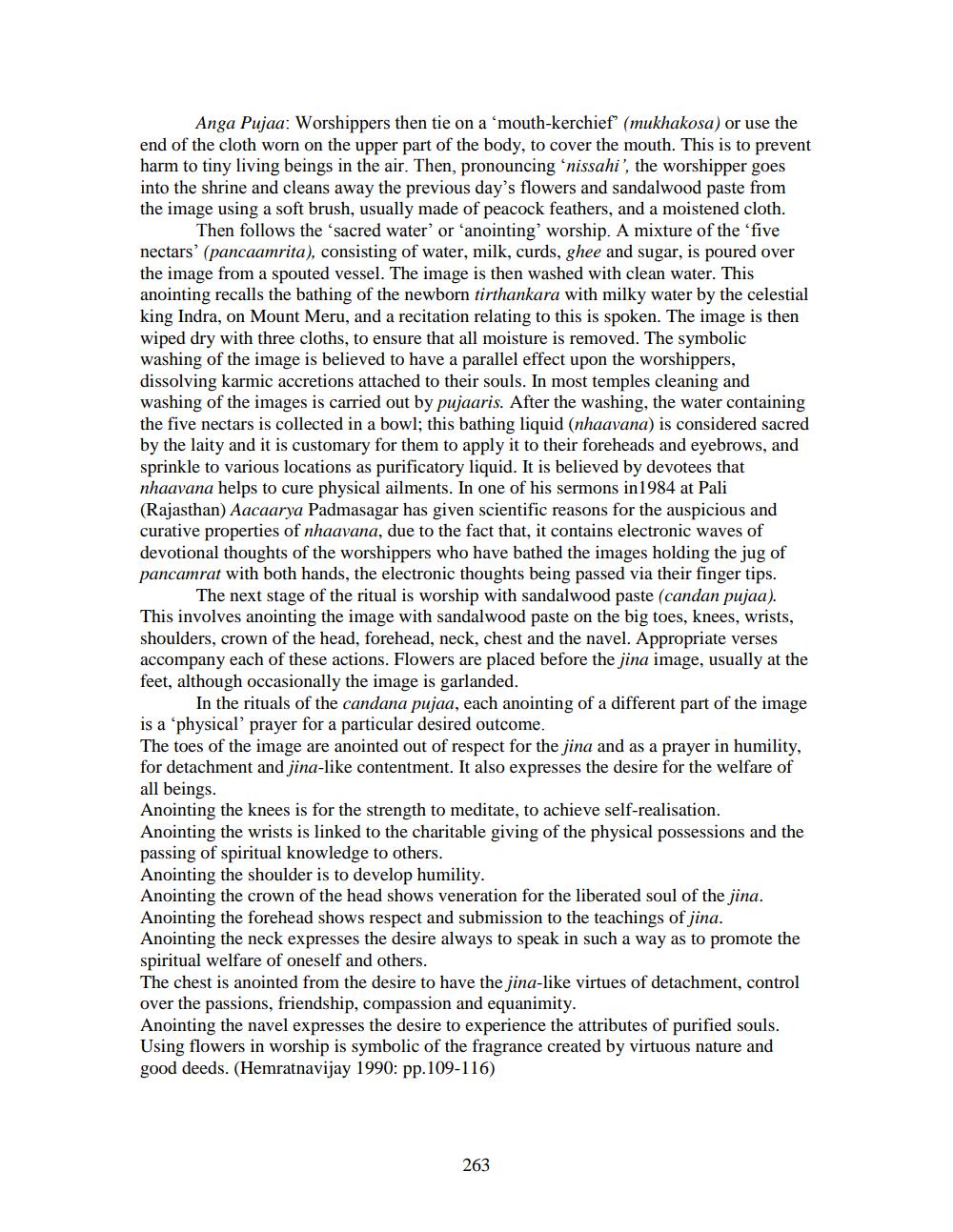________________
Anga Pujaa: Worshippers then tie on a 'mouth-kerchief" (mukhakosa) or use the end of the cloth worn on the upper part of the body, to cover the mouth. This is to prevent harm to tiny living beings in the air. Then, pronouncing 'nissahi, the worshipper goes into the shrine and cleans away the previous day's flowers and sandalwood paste from the image using a soft brush, usually made of peacock feathers, and a moistened cloth. Then follows the 'sacred water' or 'anointing' worship. A mixture of the 'five nectars' (pancaamrita), consisting of water, milk, curds, ghee and sugar, is poured over the image from a spouted vessel. The image is then washed with clean water. This anointing recalls the bathing of the newborn tirthankara with milky water by the celestial king Indra, on Mount Meru, and a recitation relating to this is spoken. The image is then wiped dry with three cloths, to ensure that all moisture is removed. The symbolic washing of the image is believed to have a parallel effect upon the worshippers, dissolving karmic accretions attached to their souls. In most temples cleaning and washing of the images is carried out by pujaaris. After the washing, the water containing the five nectars is collected in a bowl; this bathing liquid (nhaavana) is considered sacred by the laity and it is customary for them to apply it to their foreheads and eyebrows, and sprinkle to various locations as purificatory liquid. It is believed by devotees that nhaavana helps to cure physical ailments. In one of his sermons in1984 at Pali (Rajasthan) Aacaarya Padmasagar has given scientific reasons for the auspicious and curative properties of nhaavana, due to the fact that, it contains electronic waves of devotional thoughts of the worshippers who have bathed the images holding the jug of pancamrat with both hands, the electronic thoughts being passed via their finger tips. The next stage of the ritual is worship with sandalwood paste (candan pujaa). This involves anointing the image with sandalwood paste on the big toes, knees, wrists, shoulders, crown of the head, forehead, neck, chest and the navel. Appropriate verses accompany each of these actions. Flowers are placed before the jina image, usually at the feet, although occasionally the image is garlanded.
In the rituals of the candana pujaa, each anointing of a different part of the image is a 'physical' prayer for a particular desired outcome.
The toes of the image are anointed out of respect for the jina and as a prayer in humility, for detachment and jina-like contentment. It also expresses the desire for the welfare of all beings.
Anointing the knees is for the strength to meditate, to achieve self-realisation.
Anointing the wrists is linked to the charitable giving of the physical possessions and the passing of spiritual knowledge to others.
Anointing the shoulder is to develop humility.
Anointing the crown of the head shows veneration for the liberated soul of the jina. Anointing the forehead shows respect and submission to the teachings of jina.
Anointing the neck expresses the desire always to speak in such a way as to promote the spiritual welfare of oneself and others.
The chest is anointed from the desire to have the jina-like virtues of detachment, control over the passions, friendship, compassion and equanimity.
Anointing the navel expresses the desire to experience the attributes of purified souls. Using flowers in worship is symbolic of the fragrance created by virtuous nature and good deeds. (Hemratnavijay 1990: pp.109-116)
263




